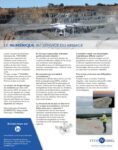Technological innovation continues to push the boundaries of air defense. At the heart of these advancements, the Iron Beam system emerges as a revolutionary high-energy laser weapon. Developed by the Israeli company Rafael, it promises to transform the national security landscape.
Integrated into the Israeli air defense network, Iron Beam will work in synergy with the Iron Dome systems, thereby enhancing protection against a multitude of threats such as rockets, missiles, and drones. This collaboration follows a $536 million arms agreement signed with Rafael and Elbit, distributing responsibilities at 60% and 40% respectively. Unlike costly traditional interceptions, the use of laser energy offers an economical solution, substantially reducing costs per interception. However, Iron Beam must still overcome challenges such as managing massive barrages of projectiles and adverse weather conditions. With this advancement, Israel strengthens its air shield, adapting to modern threats with ingenuity and efficiency.
Since its presentation at the Singapore Air Show in February 2014, Iron Beam has consistently demonstrated its potential through multiple tests in southern Israel. These demonstrations have confirmed its ability to effectively neutralize various types of threats, propelling the system towards a vital operational phase. The upcoming integration within the Israeli air defense network reflects the confidence placed by the Ministry of Defense, led by retired Major General Eyal Zamir. In addition to existing infrastructures, this laser system represents a major strategic advance, combining technological precision and economic viability.
In the face of challenges posed by terrorist groups such as Hamas, as well as repeated attacks from Lebanon, Iraq, and Yemen, the need for a robust and adaptable air defense is more crucial than ever. Traditional systems, while effective, involve high costs for each interception, which can quickly become unsustainable against massive assaults. Iron Beam, by offering an electric energy-based alternative, provides a sustainable and scalable solution, allowing it to respond to a variety of threats without compromising financial resources.
However, the laser technology is not without limitations. The ability of Iron Beam to manage large quantities of projectiles simultaneously remains to be perfected, just as its performance under adverse weather conditions such as clouds, rain, or sandstorms needs enhancement. These technological challenges require ongoing research and adjustments to ensure optimal efficiency in all combat situations. Nevertheless, the potential benefits far outweigh the obstacles, placing Iron Beam at the forefront of modern defense solutions.
Ultimately, the introduction of Iron Beam into the Israeli air defense system represents a remarkable fusion of technological innovation and military strategy. This initiative underscores Israel’s commitment to protecting its borders with cutting-edge means, while optimizing costs and enhancing resilience against current and future threats. As Iron Beam fully integrates into the national defense network, its potential impact on regional and global security is already being felt, heralding a new era in air defense.

Table des matières
ToggleThe Iron Beam System: What is it?
The Iron Beam is a cutting-edge air defense system developed by the Israeli company Rafael Advanced Defense Systems. Introduced for the first time at the Singapore Air Show in February 2014, this laser defense system represents a significant innovation in the field of air security. Designed to intercept a variety of airborne threats such as rockets, drones, cruise missiles, and mortar bombs, the Iron Beam uses high-energy laser rays to neutralize these targets with remarkable precision.
Unlike traditional defense systems that use costly interceptor missiles, the Iron Beam offers a more economical solution by using electrical energy to generate laser beams capable of disabling threats as they approach. This technology not only reduces operational costs but also increases the efficiency of air defenses by providing a quick and targeted response against imminent attacks. After demonstrating its capabilities during several tests in southern Israel about three years ago, the Iron Beam is now undergoing operational development and adaptation for deployment in the battlefield.
The system relies on a close collaboration between Rafael, the main developer of the Iron Beam, and Elbit Systems, which supplies the necessary laser cannon for its operation. This technological synergy aims to strengthen Israel’s air defense network by integrating the Iron Beam with existing systems such as the renowned Iron Dome. This combination creates a more robust and diverse defense envelope capable of countering a wide range of threats with increased efficiency.
To learn more about laser targeting technologies and their revolutionary impact, you can consult this detailed article on laser targeting systems.
How does Iron Beam integrate into Israel’s air defense system?
The integration of Iron Beam into Israel’s overall air defense system represents a major step in strengthening national security. According to the Israeli Ministry of Defense, Iron Beam will be operationally integrated into the network of Israeli air defense weapons within a year. This integration occurs alongside existing Iron Dome batteries, thus forming an additional layer of protection against a variety of air threats.
The Director General of the Ministry of Defense, retired Major General Eyal Zamir, announced the signing of an arms agreement with Rafael and Elbit to accelerate the development of Iron Beam. This agreement, worth 2 billion shekels (approximately $536 million), distributes responsibilities between Rafael, holding about 60% of the project, and Elbit, which is responsible for the remaining 40%. This strategic collaboration allows for the pooling of expertise and resources for rapid and effective implementation of the system.
The head of military research, Daniel Gold, emphasizes that the combination of laser interception and missile interception greatly strengthens Israel’s air defense. This synergy provides a more flexible and cost-effective response capability against diverse threats such as rockets, missiles, drones, and cruise missiles. By integrating Iron Beam, the Israeli air defense system becomes more resilient and adaptable to evolving enemy tactics.
Moreover, Iron Beam offers additional coverage in areas where Iron Dome may be saturated by a large number of simultaneous strikes. By using lasers to quickly neutralize emerging threats, the system allows missile batteries to be freed for more significant or complex targets. This integrated approach optimizes the use of available resources and overall enhances the effectiveness of national air defense.
What are the economic advantages of Iron Beam laser?
One of the main assets of Iron Beam lies in its significant economic advantages compared to traditional defense systems. The cost of an intercepting missile used by the Iron Dome, such as the Tamir missile, is around $100,000. In contrast, the interception cost with Iron Beam is reduced to just the electricity costs required to generate the laser beam. This cost difference can represent substantial long-term savings, especially in prolonged conflict scenarios where the number of airborne threats can be high.
By using lasers to neutralize threats, Iron Beam reduces dependency on costly missiles, making air defense more sustainable and economically viable. This approach is particularly relevant in the face of repeated attacks by drones and rockets, which can quickly deplete missile stocks if relying solely on systems that intercept projectiles. Iron Beam thus provides an economic alternative to maintain effective defense without requiring constant investment in new interceptor missiles.
Furthermore, the use of laser technology not only reduces the acquisition costs of weapons but also decreases the maintenance costs associated with complex missile systems. Lasers require fewer moving parts and are generally easier to maintain, leading to lower operational costs and longer system lifespan. This increased efficiency allows the Israeli military to deploy financial resources saved into other strategic areas.
Additionally, the technological innovation developed for Iron Beam positions Israel as a leader in the field of laser defense technologies, opening the door to export opportunities and international collaboration. By capitalizing on this advancement, the country can not only strengthen its national security but also stimulate its local economy by exporting sophisticated defense solutions to other nations facing similar threats.
What threats can Iron Beam counter?
Iron Beam is designed to provide versatile defense against a wide range of aerial threats. Among the primary threats this system can counter are rockets, mortar bombs, drones, cruise missiles, and other unmanned flying devices. With its ability to generate high-energy laser beams, Iron Beam can neutralize these threats quickly and accurately, often before they reach their targets.
Drones, increasingly used for surveillance or as offensive weapons, represent a growing threat in modern conflicts. Iron Beam is capable of detecting and tracking these small aircraft, even those flying at low altitude, and disabling them without resorting to costly missile fire. This capability is particularly essential in densely populated or sensitive areas where the use of missiles could lead to significant collateral damage.
Moreover, Iron Beam is effective against cruise missiles, sophisticated weapons capable of maneuvering in flight and circumventing conventional defenses. The precision of lasers allows for tracking and engaging these missiles with high accuracy, thus reducing the risk of significant damage. Additionally, cruise missiles are often reusable, which requires a rapid and repeated response, a task that Iron Beam accomplishes effectively due to its lower operating costs.
Finally, Iron Beam can be programmed to track moving targets, offering essential operational flexibility in dynamic combat situations. This capability allows for a quick reaction to unexpected attacks and adapts to changing enemy tactics, thus ensuring a robust and adaptable air defense against emerging threats.
What are the challenges and limitations of Iron Beam?
Although Iron Beam represents a significant advance in air defense systems, it also presents certain limitations and technical challenges. One of the main challenges lies in its ability to handle a large number of simultaneous threats. Unlike Iron Dome, which can manage massive barrages of rockets due to its multiple missile batteries, Iron Beam may struggle to track and neutralize many targets at once due to power constraints and coordination of laser beams.
Additionally, the performance of Iron Beam may be affected by adverse weather conditions such as clouds, rain, or sandstorms. Particles present in the atmosphere can attenuate the power of lasers, thereby reducing the efficiency of the system in less favorable environments. This limitation imposes a dependence on weather conditions to ensure optimal defense, which could restrict the use of Iron Beam in certain situations.
Another technical challenge concerns the thermal management of high-energy lasers. Generating and maintaining powerful laser beams require sophisticated cooling systems to prevent overheating of components. Integrating these cooling systems while maintaining the portability and operational efficiency of the system presents a significant challenge for the engineers involved.
Finally, despite the economic advantages of the Iron Beam laser, the initial cost of developing and deploying large-scale laser technology remains high. The investments required to establish adequate infrastructures and train personnel to operate this new system can pose a significant obstacle, especially in the early phases of deployment.
Nevertheless, ongoing research and development efforts and recent technological advancements promise to overcome these challenges, making Iron Beam a key player in the future of modern air defenses.
What is the future scope of Iron Beam in military technologies?
Iron Beam paves the way for new possibilities in the field of military and defense technologies. By combining laser defense capabilities with traditional systems like Iron Dome, Israel positions itself at the forefront of innovations in security. This technology has the potential to transform the way armed forces react to airborne threats, offering faster, more precise, and more economical solutions.
In the future, Iron Beam could be integrated into larger defense networks, including advanced surveillance systems and autonomous platforms for even more effective responses. Ongoing development of laser technologies could also enhance the range and power of defense systems, making them capable of neutralizing even more diverse and sophisticated threats.
Furthermore, innovations surrounding Iron Beam could extend beyond the military domain, influencing sectors such as cybersecurity and space technologies. High-energy lasers are already finding applications in various industries, and advancements made for defense systems could stimulate new research and developments in related fields.
International collaboration and strategic partnerships will also be essential to maximize the potential of Iron Beam. By sharing knowledge and resources with other nations and technology companies, Israel can accelerate the evolution of this technology and ensure its position as a global leader in laser air defense.
How does Iron Beam change the dynamics of modern conflicts?
The introduction of Iron Beam into the landscape of Israeli air defenses marks a turning point in the dynamics of modern conflicts. By providing an alternative to traditional missile-based defense systems, Iron Beam alters the offensive and defensive strategies of military actors. Potential adversaries must now take into account the presence of sophisticated laser defense systems capable of quickly neutralizing their aerial weapons, which can deter attacks and modify combat tactics.
Moreover, the effectiveness and speed of lasers allow for almost instantaneous responses to threats, reducing the reaction time required for defenses. This can prevent surprise attacks and limit damage caused by enemy projectiles. Consequently, armed forces must reassess their attack strategies, favoring more discreet or diversified approaches to bypass advanced laser defenses.
Additionally, the decrease in costs associated with using lasers for air defense may encourage a broader and more extensive deployment of these systems, further strengthening national security. This evolution could prompt other nations to invest in similar technologies, triggering an arms race in laser defense and redefining power balances in international conflicts.
Finally, the ability to neutralize threats without resorting to explosive ordnance or missile debris offers advantages in terms of civil safety and reducing collateral damage. This is particularly crucial in urban areas where risks to civilian populations are high. Iron Beam, as a clean and precise air defense system, aligns with contemporary objectives of minimizing human losses and preserving critical infrastructures.























